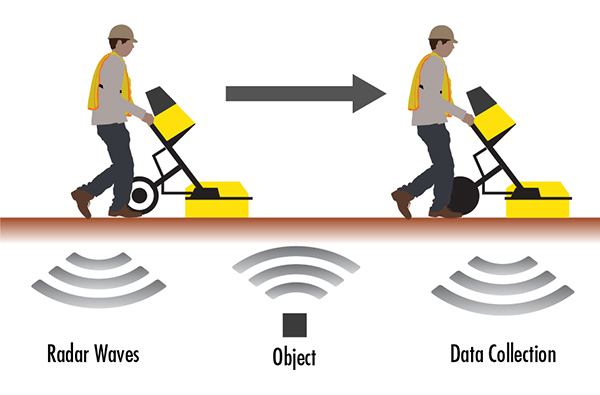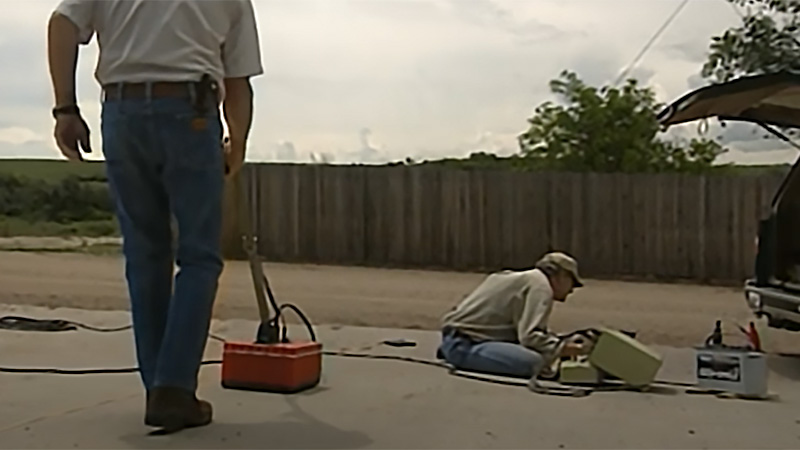Forensic Tools/Techniques:
Ground-Penetrating Radar
Posted: December 5, 2021
By: Robert S.
When one thinks of radar, they often conjure images of World War II aircraft or submarines with a small, monochrome screen. This usually includes a sweeping line, like a clock's second-hand, rotating rapidly and indicating various blips on screen. And only the trained radar tech knows how to accurately interpret the cryptic data, warning the crew of impending danger.
Radar has come a long way since the 1940s. Secretly developed for the war effort, RADAR (radio detection and ranging) has found a wide range of non-military uses. We now rely on radar technology for air traffic control, weather prediction and even self-driving cars.
Typical radar systems use set of components usually consisting of a transmitter (to send out the radio waves), a receiver (an antenna to receive the reflected waves) and a processor (to make sense of the data). Developed to use the frequencies in the radio bands of the electromagnetic spectrum, different types of radar can take advantage of other frequencies. More advanced systems use multiple antennas of varying frequencies, GPS integration and advanced signal processing software.
What is ground-penetrating radar?
The radio waves broadcast and received can travel through more than just air. Through water, submarines have preferred sound waves (sonar), but using radar against solid objects has found its value. These are commonly known as ground-penetrating radar systems, but their uses go far beyond just the ground. By using a variety of frequencies, the radio waves of GPR can penetrate wood, stone, brick, and many other solid surfaces.
How is ground-penetrating radar used?
Ground-penetrating radar (GPR) is a specific type of geophysical survey system. Everyday uses of GPR include detection of underground utilities and structures, typically used for civil engineering. Locating an underground storage tank or buried utility line before digging can save both time and money. Also, detecting natural ground conditions can help with roadway construction, landfill studies, and sinkhole prevention.
In the world of forensics, ground-penetrating radar has made a significant mark, and its use continues to grow as systems become more affordable. From locating a cache of drugs behind a solid wall to determining if the earth has been disturbed at a potential burial site (or even locating a body), GPR is like x-ray vision to police. By surveying the ground before excavating, radar can tell investigators if they're on the right track. And just a valuable, discovering no evidence at a location can save the authorities resources by not committing them down a dead-end path.
When scanning an area, technicians usually start with a broad, preliminary survey of the whole area. Upon identifying a potentially significant area, a more detailed sweep is performed. The depth and detail of the radar scan is determined by the radio frequency the GPR uses. Ground-penetrating radar typically uses the 400 MHz frequency of radio waves to locate something around the size of a human head up to 15 feet below ground (with good soil conditions). A lower frequency can "see" even deeper, but with less detail.
Detecting Buried Remains Using Ground-Penetrating Radar
In 2012, a report commissioned by the U.S. Department of Justice was published by John J. Schultz, Ph.D. from the University of Central Florida (Go Knights!). The project began in 2008 and its purpose was "to determine the applicability of GPR for detecting controlled graves".
Using pig carcasses, a series of graves were dug at different depths and monitored for up to 2.5 years using both electromagnetic induction (EMI) and ground-penetrating radar (GPR). The results of this detailed study are available on the Office of Justice Programs web site.
How much does ground-penetrating radar cost?
For law enforcement's investigative purposes, the cost of GPR can be inhibitive. The equipment – typically consisting of a cart, antenna, battery, controller, and software – can run an agency anywhere from $10,000 up to $25,000. And this price doesn't include the training courses needed for technicians to maximize the ground-penetrating radar's utility.
But as the technology improves, hopefully prices will come down. And often, an agency can see a return on their investment when GPR is used to solve more cases, convict more criminals, and recover more goods. For important cases, an agency will often borrow the equipment (and expertise) from another area, or they'll contract the task out to a private company.
Forensic Files episodes that feature ground-penetrating radar
Season 4, Episode 11: Haunting Vision
This episode documented the nearly three-decade search for missing mother DiAnne Keidel. Her youngest daughter Lori had witnessed her father killing DiAnne and burying her body in the backyard of their house. Even though she was only five years old at the time, the memory of this horrible event was clearly etched in her mind.
When Lori approached the police over 25 years after that horrible night in 1966, the information she shared was compelling. But witnessed at such a young age so many years ago, investigators would need to gather additional evidence before opening the murder case. Even though the area of her mother's grave had been paved over and the house sold, Lori was able to show detectives the site of the burial.
The folks who owned the home after the Keidels moved out certainly didn't want police to dig up their patio on a hunch based on a five-year-old's eyewitness account. So, ground-penetrating radar was the key. Zeroing in on the location indicated by Lori, the Colorado organization NercroSearch brought a GDP unit to the site and surveyed the area. Doing no damage, they were able to locate a significant ground disturbance, approximate the size of a human body. It was exactly where Lori had indicated.
The remains recovered from the grave site under the patio were significant in securing a murder conviction against Lori's father Gene Keidel.
Find a typo or issue with the details of this article? Leave a comment below, or contact us!
Sources
- https://usradar.com/ground-penetrating-radar-cost/
- https://www.evidencemagazine.com/index.php?option=com_content&task=view&id=2163&Itemid=1
- https://weinspecttexas.com/the-role-of-ground-penetrating-radar-in-forensic-investigations/
- https://usradar.com/gpr-ground-penetrating-radar-applications/law-enforcement/
- https://www.ojp.gov/pdffiles1/nij/grants/238275.pdf
- https://www.kci.com/resources-insights/innovator/ground-penetrating-radar-as-part-of-sue-and-damage-prevention/


